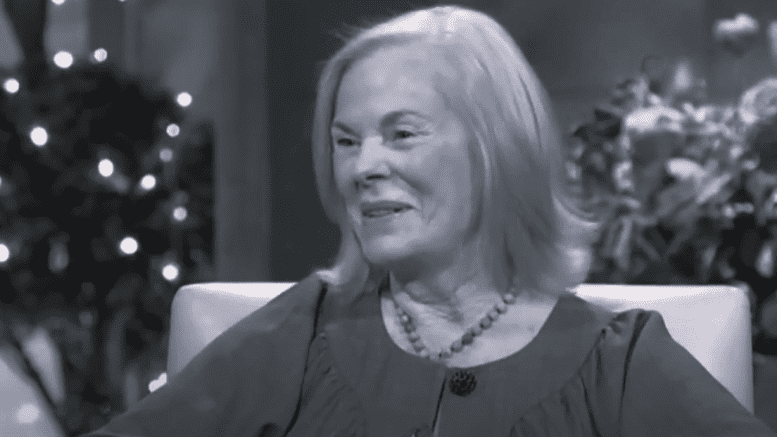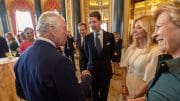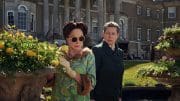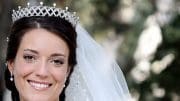The future Duchess of Kent was born Katharine Mary Lucy Worsley on 22 February 1933 as the daughter of Sir William Worsley, 4th Bt. and Joyce Brunner. She was their fourth child and first daughter.
Although the idyll of her birthplace, Hovingham Hall, might easily be romanticised, Katharine was separated from her brothers during the school term as they were all sent away to boarding school. In her early years, her mother was frequently her only companion. She was just six years old when war broke out, and she found herself being fitted for a gas mask. Around this time, a governess named Miss Evelyn Brockhurst was hired to see to Katharine’s education. However, the older Miss Evelyn Brockhurst was not much of a suitable companion for the young girl. Katharine had some contact with her older cousins, but there was to be no lasting relationship. As a result, Katharine’s childhood was to be a lonely one, though she always had a strong bond with her father.
At the age of ten, she was finally allowed to go to a traditional boarding school, though it was not far from her home, and so she attended only during the day. At the school, Castle Howard, Katharine first glimpsed at royalty when King George VI and Queen Elizabeth visited with Princess Elizabeth in 1944. When the war came to an end, Katharine danced with her friends in school, but with the war now over, she was to be sent to a proper boarding school, where her older cousins also were – Runton Hill School.
Although now offered a chance to thrive away from her family, Katharine was not happy at Runton Hill. The conditions at the school were pretty basic and bleak. However, she did play lacrosse and appeared in some of the school plays and managed to open up to a few close friends. Her main passion was music, and she could play any song on the piano by ear. She left the school at the age of 16 with several passes and credits. She then went to Miss Hubler’s finishing school in Oxford while also continuing her passion for the piano. However, she failed to get into the Royal Academy of Music, which she called “my own fault, entirely.”1 Nevertheless, these years were among the happiest of her life.
Her brothers, John and Oliver, escorted her to parties and the theatre, and so Katharine came in contact with the eligible young men of the 1950s. She met Andrew Burnaby-Atkins, a dashing officer who was almost 30. It turned out to be a “great love affair.”2 However, Katharine had no idea what she wanted to do with her life, and her parents rented a flat in London for her during her “coming out.” She was eventually hired, despite her lack of qualifications, as a kindergarten helper at an exclusive nursery. Her mother wanted her to be married, and preferably, it should be an amazing match. It’s unclear when exactly she ended her relationship with Andrew Burnaby-Atkins, but they remained friends.
In the summer of 1956, Katharine met the Duke of Kent, who had been posted nearby. Prince Edward, the Duke of Kent, was three years younger than her, and he had succeeded his father as Duke in 1942 when he was killed in a plane crash. He had been invited to lunch at Hovingham Hall by her father, and afterwards, Katharine took him to see the oil paintings, including one of hers.
Edward became a frequent visitor to Hovingham Hall, and Katharine found herself receiving invitations from other members of the royal family. Edward’s mother, Princess Marina, was less than pleased with the match as she would have preferred some European princess for her son. The romance progressed quietly, and Katharine was the only outsider to be invited to Edward’s sister’s 21st birthday party. Shortly after Katharine’s 25th birthday, Edward told his mother that he wanted to marry her, but Princess Marina told him no. She worried that Katharine would not be up to royal life, and Katharine shared those worries. For now, the wedding plans were shelved as Prince Edward was set to go to Germany for two years. Princess Marina told them not to have any contact for at least a year to be sure that they wished to marry. But as Prince Edward went to Germany, media attention on Katharine intensified.
In response, she left the country. Katharine took a friend with her to Canada, and they planned a trip by Greyhound bus to Mexico. She briefly took a job in a Canadian department store to save up more money for the trip. As she eventually reached her final destination, a bouquet of flowers was waiting for her. The card simply read “E.” Upon her return, it became clear that the wedding was to go ahead despite everyone’s reservations. Princess Marina began to train her future daughter-in-law for the life that lay ahead. For a final huzzah, Katharine escaped to Rome for the 1960 Olympics.
On 1 January 1961, the Duke of Kent proposed to Katharine in the library at Hovingham Hall with a ring of sapphire and diamonds. He requested and received official permission from Queen Elizabeth II. A friend of the Duke later said, “I suspect she undertook the marriage partly out of a sense of duty. [..] I suspect she had no wish to enter into the royal world of protocol. She would have been happier with a good county marriage.”3
On 8 June 1961, Katharine walked down the aisle of York Minster to marry the Duke of Kent. Her gown was commissioned from John Cavanagh, and it was made of more than 250 yards of white silk gauze. She wore pearls, which were a gift from her parents. She wore a long veil that fell over her 15-foot train, which was secured with a bandeau of diamonds. Princess Anne was her chief bridesmaid. She emerged as Her Royal Highness The Duchess of Kent.
The newlyweds moved into Coppins, which her mother-in-law had vacated. By Christmas, it was apparent that Katharine was pregnant with her first child. On 26 June 1962, she gave birth to a son named George Philip Nicolas, who went by the courtesy title of Earl of St Andrews. Not much later, the Duke and Duchess went to Uganda for their independence celebrations. Although she had never been an extraordinary student, she now “did her homework.”4 From then on, she was always impeccably prepared for all engagements.
Not much later, Prince Edward was posted to Hong Kong, and Katharine and their son travelled with him. In the autumn of 1963, Katharine fell pregnant with her second child, just as Edward was posted to Germany. Katharine chose to have the baby in the UK, where three other royal women were also pregnant. Queen Elizabeth II was pregnant with Prince Edward, Princess Margaret was pregnant with Lady Sarah, and Princess Alexandra was pregnant with James. On 29 April 1964, Katharine gave birth to a daughter named Helen Marina Lucy. As the daughter of a Duke, she carried the courtesy title of Lady. Prince Edward had arrived home just in time for the birth. Her recovery after the birth was slow and perhaps hinted at some kind of postpartum depression. During these years, Katharine lived mainly as an officer’s wife, though they were sometimes called upon to carry out engagements.
On 27 August 1968, her mother-in-law, Princess Marina, died at Kensington Palace of a brain tumour. Katharine’s relationship with Marina had been complicated, but now she had inherited her work. She took on several new patronages and offices, and the number of royal engagements now filled her diary. In 1969, she and her husband headed to Australia, New Guinea, the British Solomon Islands, and the New Hebrides, but by the time they reached Perth, the strain on Katharine’s health was already becoming clear. Nevertheless, she brushed it off and carried on. At the end of the year, her third pregnancy was confirmed. On 25 July 1970, she gave birth to a second son named Nicholas Charles Edward Jonathan. As the second son of a Duke, he carried the courtesy title of Lord. The following year, they sold Coppins and moved into York House.
Katharine desperately longed for more children, and she finally fell pregnant again in 1975. However, on 30 April 1975, newspapers reported that Katharine had fallen ill with German measles. This, combined with an early pregnancy, could cause damage to the unborn child, such as defects to the heart, brain and eyes. Princess Christina of the Netherlands was born blind in one eye and with cataracts in the other eye following her mother’s infection with measles. Often, the mother would suffer a miscarriage. Her doctors advised Katharine to have an abortion, but she turned to the church for a second opinion. They told her that if the medical advice was to have an abortion, she would be committing no fault. In the end, she chose abortion.
These years were unhappy times in the Kent marriage. In 1976, she was admitted to the hospital and was diagnosed with mild anaemia. Around this time, the Duke decided to leave the army and was appointed vice-chairman of the British Overseas Trade Board. The following year, Katharine was elated to discover that she was once again pregnant. On 4 October 1977, she gave birth to a third son, who was tragically stillborn. She named the boy Patrick. In a later interview, she said, “It had the most devastating effect on me. I had no idea how devastating such a thing could be to any woman… I suffered from acute depression for a while. I think it would be a fairly rare individual who didn’t cave in under those circumstances. The baby was born dead at nine months. It was a horrible thing to happen.”5
Although she continued with her engagements, which included handing out trophies at Wimbledon. However, the deaths of her father and mother during these years only made matters worse. Desperate to avoid embarrassing or offending Queen Elizabeth II or the royal family, Katharine carried on. In 1978, she was eventually hospitalised for several weeks due to a “nervous strain.”6 By then, her marriage was also on the point of collapse as Edward reportedly had no idea how to deal with Katharine’s mental distress. However, they eventually agreed that their marriage would survive. Slowly but surely, she battled through.
The first of their children to marry was their eldest son, George. In 1988, he married Sylvana Tomaselli. Katharine was on the fence about her new daughter-in-law, but would anyone ever be good enough? Queen Elizabeth II officially gave her consent to the match, but as Sylvana was a Catholic, George would lose his place in the line of succession. Less than a year after the marriage, they welcomed their first child – a son. He was named Edward, and as the eventual heir to the Dukedom, he carried the courtesy title of Lord Downpatrick. Two daughters were also born to them.
Her son Nicholas caused quite some concern as he reportedly suffered from an eating disorder, which Katharine found particularly hard to bear. Her daughter Helen was the second to be married in 1992. She married Timothy Taylor with the consent of The Queen. They went on to have four children.
Katharine was received into the Catholic Church on 14 January 1994, a wish that had been growing for more than 30 years. She later said in an interview, “I do love guidelines, and the Catholic Church offers you guidelines. I have always wanted that in my life: I like to know what is expected of me. I like being told: ‘You shall go to church on Sunday, and, if not, you’re in for it.'”7 In 1996, a new health challenge presented itself when Katharine was diagnosed with ME or chronic fatigue syndrome.8 She was also diagnosed with possibly having coeliac disease, which could also account for her exhaustion as she was not properly absorbing food.9
By the late 90s, Katharine and Edward’s children were all grown up, and they basically lived separate lives with separate agendas and hobbies. The Duchess began to retreat from her royal life slowly and even took up a regular job, working as a music teacher in Hull. During her time there, she was known as “Mrs Kent” or “Katharine Kent.” She later said, “When I was teaching, the first thing I began to notice was the power of music as a stimulant to these children to give them confidence and self-belief. I began to see that happen all the time.”10 Katharine briefly left teaching and launched a music charity called Future Talent, which helps children to develop their musical talent. Then, she reportedly returned to teaching children who lived in Grenfell Tower.
The Duchess of Kent became the oldest living member of the British royal family, following the death of Queen Elizabeth II.
Katharine died on 4 September 2025 at the age of 92 at Kensington Palace, surrounded by her family.
- The Duchess of Kent: the troubled life of Katharine Worsley by Mary Riddell p.58
- The Duchess of Kent: the troubled life of Katharine Worsley by Mary Riddell p.62
- The Duchess of Kent: the troubled life of Katharine Worsley by Mary Riddell p.87
- The Duchess of Kent: the troubled life of Katharine Worsley by Mary Riddell p.108
- The Duchess of Kent: the troubled life of Katharine Worsley by Mary Riddell p.156
- The Duchess of Kent: the troubled life of Katharine Worsley by Mary Riddell p.160
- The Duchess of Kent: the troubled life of Katharine Worsley by Mary Riddell p.269
- Herald Scotland
- The Duchess of Kent: the troubled life of Katharine Worsley by Mary Riddell p.362
- Huffington Post






Be the first to comment on "The Duchess of Kent – A reluctant royal"